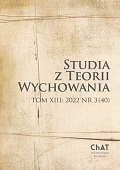Nowoczesne technologie asystujące wspomagające komunikację, edukację oraz funkcjonowanie społeczne osób z uszkodzonym narządem słuchu
Modern assistive and augmentative technologies supporting communication, education and social functioning of individuals with hearing impairment
Author(s): Małgorzata Kupisiewicz, Paulina ZagrobelnaSubject(s): Social Sciences, Education
Published by: Wydawnictwo Naukowe ChAT
Keywords: hard-of-hearing individuals; deaf/Deaf individuals; assistive technologies; quality of life
Summary/Abstract: Hearing disability and its consequences are approached taking into consideration two viewpoints: medical-rehabilitative that exposes a hearing deficit and limitations of access to the world of sounds, including speech and communication in phonic language; and sociocultural that does not perceive deafness as disability but as a positive value in the Community of the Deaf – people who qualify as a linguistic and cultural minority that communicate using sign language. Currently, at the time of intense development of new technologies, new prospects and opportunities are created that change the face of hearing disability and the Deaf Community. This article attempts to show selected modern assistive technologies and how they might affect improvement of the quality of life of hearing impaired and deaf/Deaf individuals. The focus of the article is on demonstrating the importance of the functional assistive devices and other technologies as strategies of mitigating, preventing or compensating the difficulties related to interpersonal and social communication, increasing access to education and public space for people with hearing impairment and also enhancing their ability to participate in social life independently and unassisted. Key words: hard-of-hearing individuals, deaf/Deaf individuals, assistive technologies, quality of life. Niepełnosprawność słuchowa i jej następstwa rozpatrywane są z uwzględnieniem dwóch orientacji: medyczno-rehabilitacyjnej eksponującej deficyt słuchu i ograniczania dostępu do świata dźwięków, w tym mowy oraz komunikowania się w języku fonicznym; oraz socjokulturowej, gdzie głuchota nie jest traktowana jak niepełnosprawność, lecz posiada rangę pozytywnej wartości w społeczności Głuchych, osób stanowiących mniejszość językowo-kulturową, komunikujących się językiem migowym. W obecnej dobie intensywnego rozwoju nowoczesnych technologii otwierają się nowe perspektywy i możliwości zmieniając oblicze niepełnosprawności słuchowej i społeczności Głuchych. W artykule podjęto próbę ukazania, jakie nowoczesne technologie wspomagające, i w jaki sposób mogą wpłynąć na poprawę jakości życia osób słabosłyszących, niesłyszących/Głuchych. Uwaga skoncentrowana jest na ukazaniu wartości funkcjonalnych urządzeń wspomagających i innych technologii, jako strategii łagodzenia, przeciwdziałania lub kompensowania trudności związanych z komunikacją interpersonalną i społeczną, zwiększania dostępności edukacji oraz przestrzeni publicznej dla osób z uszkodzonym narządem słuchu oraz ich zdolności do samodzielnego i niezależnego uczestnictwa w życiu społecznym. Słowa kluczowe: osoby słabosłyszące, niesłyszące/Głuche, technologie wspomagające, jakość życia.
Journal: Studia z Teorii Wychowania
- Issue Year: XIII/2022
- Issue No: 3 (40)
- Page Range: 279-300
- Page Count: 22
- Language: Polish

